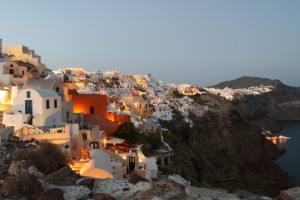Bask in the splendors of the ancient world on this 15-day Greece tour. Explore the Acropolis and the Arch of Hadrian in Athens. See where the Olympic Games began in 776 B.C at the Temple of Zeus and in the city of Mycenae, take in the giant Cyclopean stones. Thessaloniki’s markets tempt you with regional delicacies and a local beekeeper invites you to tour his family-run honey farm. On the romantic isle of Crete, stroll medieval towns and get up close and personal with archaeological finds.
Chania
Chania
The beautiful town of Chania is where modern, Venetian, Turkish and traditional architecture are blended together to make this one of the most picturesque towns in Crete. Various archaeological sites, villages, churches, caves, gorges and wonderful beaches are embellishing the charming area. It is worth a visit to the Archeological museum that is housed in the Venetian church of St. Fragiskos and exhibits important finds from the Neolithic and Minoan period to the late Roman.
|
Destination Guide
|
Heraklion
Heraklion
Heraklion, the capital of Crete and its principal commercial port, is just three miles away from the fantastic ruins of the Palace of Knossos. Discovered in 1899 by Sir Arthur Evans and partially reconstructed, the elaborate Palace is believed to be the mythical Labyrinth of King Minos and the seat of ancient Minoan culture. The Archaeological Museum in Heraklion displays many of the treasures found during the excavations.
|
Destination Guide
|
Nafplion (Nauplia)
Nafplion (Nauplia)
A former capital of Greece and a popular port on the eastern Peloponnese coast, Nafplion impresses visitors with grand, medieval architecture erected by Venetians during the 15th century. The most dominant structure is Palamidi Fortress towering high above town. The port is a lively town with a scenic harbor, a picturesque center to explore on foot and pebble beaches. Several monuments remain from its Turkish past, including mosques and parliament building. Handicrafts and local costumes are on display at the Folk Art Museum. Palamidi Castle has an incomparable view from the fortress’ lofty position. Spend time strolling along the waterfront, exploring around main square and narrow streets of Old Town. Platia Sintagmator, the city’s main square, is fronted by a former mosque, now the meeting place of Greek Parliament. Here is also the Archaeological Museum, which features an outstanding collection of Mycenaean finds. The entrance to Akronafplia Citadel has a gate built of Roman bricks, a Byzantine gatehouse with frescoes dating from 1291, and Venetian bastions.
From the port, don't pass up a tour to Mycenae. There is evidence that the site has been inhabited since 4000 BC, but reached its peak of civilization during 1500 - 1000 BC. It was here that the mighty Agamemnon ruled and the site still contains massive structures which give visitors a glimpse of what this magnificent city once was.
|
Destination Guide
|
Delphi
Delphi
Itea is the port for Delphi, one of the ancient wonders of classical Greece. A short drive there reveals the Sacred Way and the famed Shrine of Delphi, where the mythological Oracle was said to foretell the future. An amazing bronze charioteer is among the many treasures in the Delphi Museum.
|
Destination Guide
|
Galaxidhi
Galaxidhi
Galaxidi lies on the Gulf of Corinth, across the bay from Itea, itself only a few miles below Delphi. The island atmosphere used to be heightened by the fact that, before the main road was built, Galaxidi was most easily reached by ferry from Itea. It has a virtually unspoiled core of grand bourgeois houses (arhontika), some of which rest on sturdy lengths of ancient wall. Cross the water to Itea and from there a short coach journey to Delphi, perhaps the most magical classical site in Greece.
|
|
|
Ioannina
|
|
Thessaloniki
Thessaloniki
Thessaloniki is Greece’s second largest city, busiest seaport after Piraeus, major cultural center in northern Greece, and capital of Macedonia. Prehistoric remains in the city’s vicinity show the area was settled as far back as 1000 B.C. Thessaloniki is considered more cosmopolitan than Athens. In 1997, the European Community honored the city with title of “Cultural Capital of Europe.” Although many older buildings were destroyed in a 1917 fire and during bombing attacks in World War II, the city still has historical landmarks ranging from the 15th century Venetian Tower to the Arch of Galerius. There are also magnificent churches. The main hub centers around Aristotle Square, a traffic-free area surrounded by arcades with cafes and restaurants. The pedestrian strip along the water’s edge is a popular seafront promenade. Main thoroughfares, Odos Mitropoleos and Odos Tsimski, are lined with luxury shops and boutiques. On Aristotle Street is the picturesque Central Market. Paradise Baths, a Turkish bathhouse dating from 1444, is still in use today.
|
Destination Guide
|
Athens
Athens
Even though you've probably come here to see the "glory that was Greece," perhaps best symbolized by the Parthenon and the superb statues and vases in the National Archaeological Museum, allow some time to make haste slowly in Athens. Your best moments may come sitting at a small cafe, sipping a tiny cup of the sweet sludge that the Greeks call coffee, or getting hopelessly lost in the Plaka -- only to find yourself in the shady courtyard of an old church, or suddenly face to face with an ancient monument you never knew existed. With only a little advance planning, you can find a good hotel here, eat well in convivial restaurants, enjoy local customs such as the refreshing afternoon siesta and the leisurely evening volta (promenade or stroll) -- and leave Athens planning to return, as the Greeks say, tou chronou (next year).
|
Destination Guide
|






